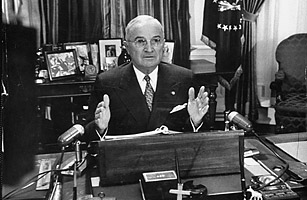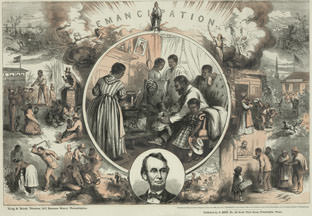
This Day in Labor History: April 8, 1952. President Truman nationalized the steel industry in order to forestall a strike scheduled the next day that would have shut down steel production during the Korean War, a move that horrified the steel companies! Let's talk about it! 

The steel industry was probably the most hostile large industry to organized labor.
Although the Steel Workers Organizing Committee managed to force U.S. Steel to negotiate a contract in 1937, the smaller steel companies held on until Franklin Roosevelt forced their hand in 1942, engaging in some of the harshest labor violence of the 1930s along the way.
This hostility had not abated by the 1950s. Steel companies wanted to crush what was now the United Steelworkers of America and take back control over their plants.
World War II taught a hard lesson to organized labor–tying price control to wage rates as happened during that conflict meant that workers would not share in wartime profits.
There was tremendous working-class militancy during the war over wages, which labor leaders worked very hard to suppress in order to continue production. This pent up anger led to the strike wave of 1946 that in turn spawned the Taft-Hartley Act and other anti-union legislation.
When the Korean War began in 1950, President Truman wanted to avoid similar conflicts. He thus created the Wage Stabilization Board that would judge wage requests from labor independently of prices, which fell under the Office of Price Stabilization.
In 1951, contracts talked began to break down between the USWA and the steel industry, with US Steel, Bethlehem Steel, and other companies balking at wage hikes. US Steel refused to even talk about wages after September 1951.
The USWA made it clear that they were organizing industry-wide and refused to do so company by company, which would have given the corporations much more power in the process. Tensions within the USWA also rose during the talks.
The USWA strike committee specifically refused to grant USWA and CIO President Philip Murray the power to sign a wage agreement without a vote from union membership.
In fact, the USWA had been an undemocratic union from its beginnings so there was reason to be concerned here. Allowing Murray such power gave him a lot of leverage to push back against labor militancy and the potential of a walkout.
On December 31, 1951, the existing contract expired. Truman ordered the WSB to mediate a solution, which labor agreed to rather than going on strike. In March, the WSB recommended a wage increase of 26 cents an hour.
The steel industry responded by demanding a similar hike in steel prices from the Office of Price Stabilization. This was starkly different from World War II, when labor’s wage gains were erased by state-mandated inflation.
The steel industry rejected the government’s mediation and refused to recognize the wage rates. This impasse led the USWA to announce a strike for April 9.
Truman was desperate to stop a labor walkout in steel during the war. Already an unpopular president, Truman had the 52 elections on his mind, hoping to hold the line for Adlai Stevenson and understanding the need to have a huge labor turnout to defeat Eisenhower that November.
Thus, he staked himself to production to win the war over union-busting, despite the popularity of the latter tactic with large swaths of the American public during the time.
On April 8, he nationalized the steel industry through Executive Order 10340, ordering Secretary of Commerce Charles Sawyer to take over the nation’s private steel mills and keep them running. The USWA immediately called off its strike and told its members to report to work.
Organized labor was ecstatic that the president would come down so decisively on their side during the dispute. Business owners and newspapers were predictably outraged.
Republicans howled about Truman caving to labor and assisting international communism, conveniently ignoring the real fault for the strike.
The steel companies sued to regain control of the plants. On June 8, the Supreme Court ruled 6-3 that Truman overstepped his authority in seizing the mills.
The government argued that as Commander in Chief the president had the obligation to ensure that critical wartime industries remained operational. Moreover, this necessity overrode the principle of private property.
The steel companies, represented by the 1924 Democratic candidate for president, John W. Davis, argued that Congress had provided Truman another way to end the strike, through the Taft-Hartley Act.
That would force the workers back to job due to the law’s clause giving presidential powers to end strikes when they impacted national safety, creating an 80-day cooling off period.
Davis argued that Congress had explicitly rejected seizures in passing Taft-Hartley and that Truman violated the separation of powers by ignoring congressional instructions on dealing with these issues. Unfortunately, the majority of the Supreme Court agreed.
This led 600,000 steelworkers to go on strike the next day, effectively ending steel production in the United States for the next 6 weeks. Factories producing tanks, trucks, bazooka rockets, and mortar shells reduced production by more than half.
Truman could have used his power under the Taft-Hartley Act to bust the strike.
He refused, blaming management for the strike and again wanting to make labor happy with the Democratic Party, although the president also openly held the possibility of drafting striking steelworkers into the military as a tool to use against the USWA staying on strike for long.
The strike lasted until July 24, when the industry caved to USWA demands, including a 21.5 cent pay hike with a $5.65 a ton rise in steel prices to partially offset those wage increases.
The union wanted a full closed shop and although it did make progress toward that goal, it was not a complete victory on that front.
More important, the USWA stood up to the steel companies, holding the line in industry representation and showing solidarity against industry intransigence. Certainly Murray and USWA leadership thought they had won a huge victory.
From perspective of Democratic Party fortunes, Truman ended up looking to his enemies both dictatorial and weak by turns.
The steel strike had little impact on the war effort, but although Truman galvanized organized labor, if anything it hurt Democratic fortunes in the 1952 elections, helping usher in Republican rule for the first time in 2 decades, although there were many reasons for this.
In the bigger picture, Truman’s support of the USWA probably had relatively little impact that fall.
Back tomorrow to discuss the end of slavery
• • •
Missing some Tweet in this thread? You can try to
force a refresh







